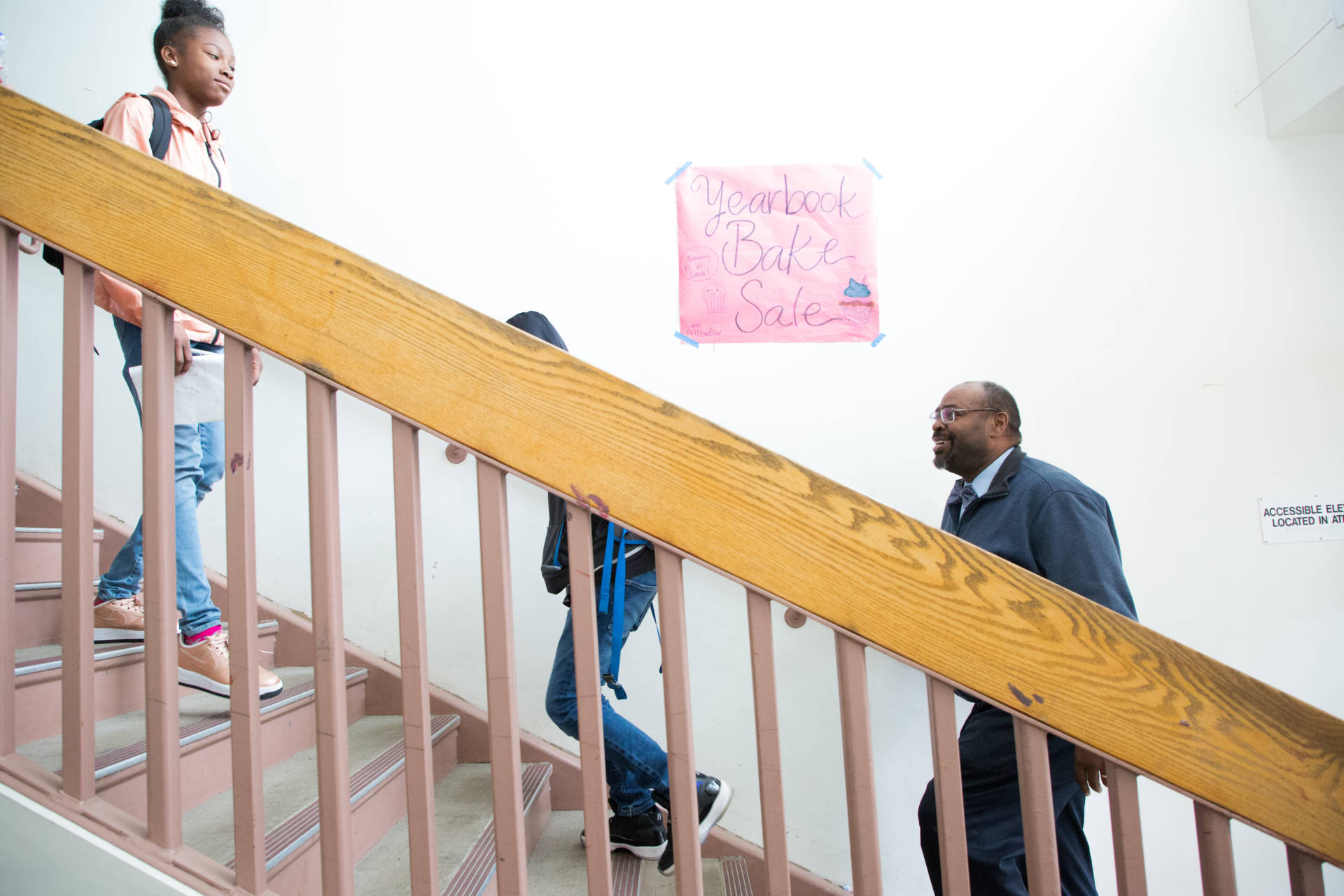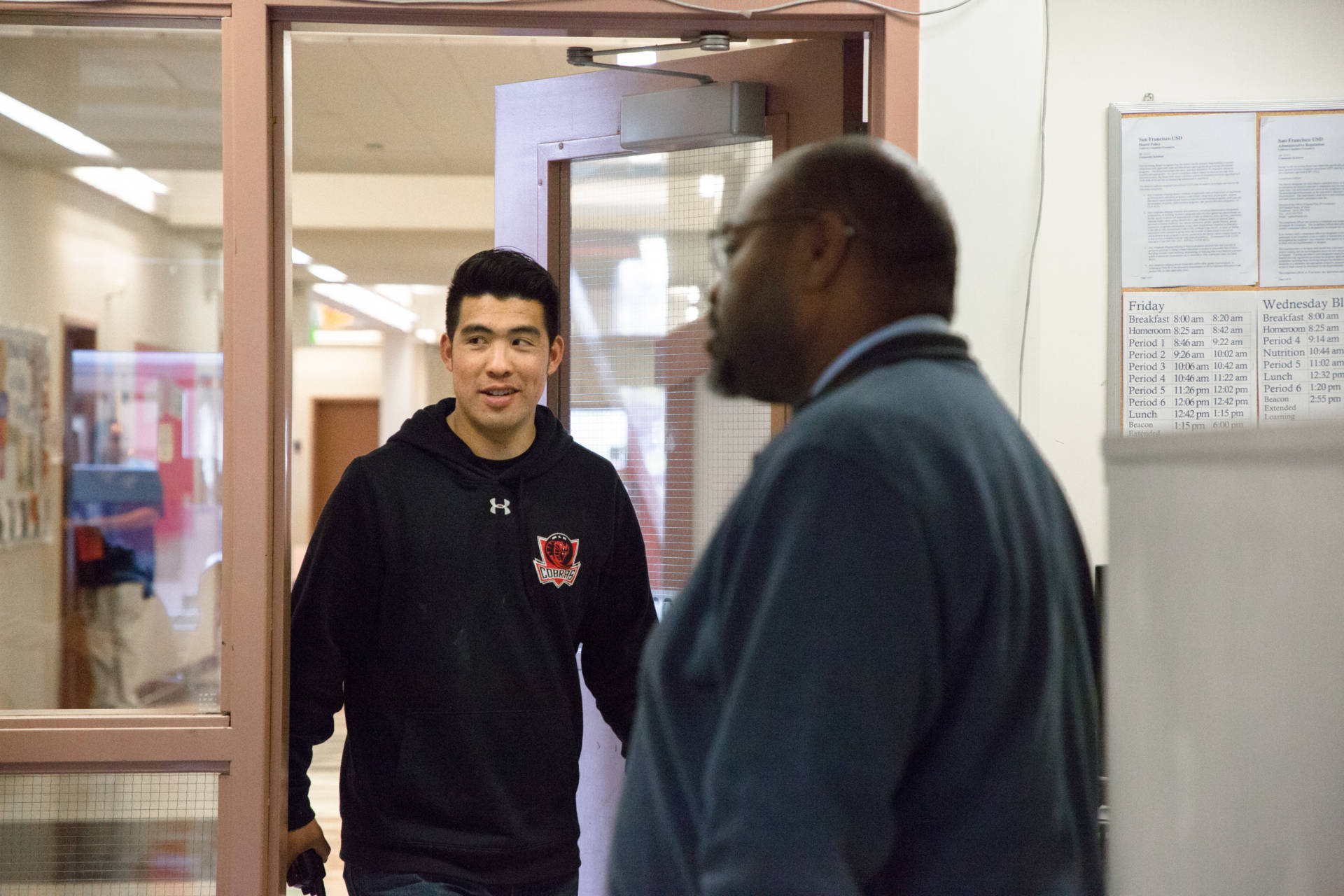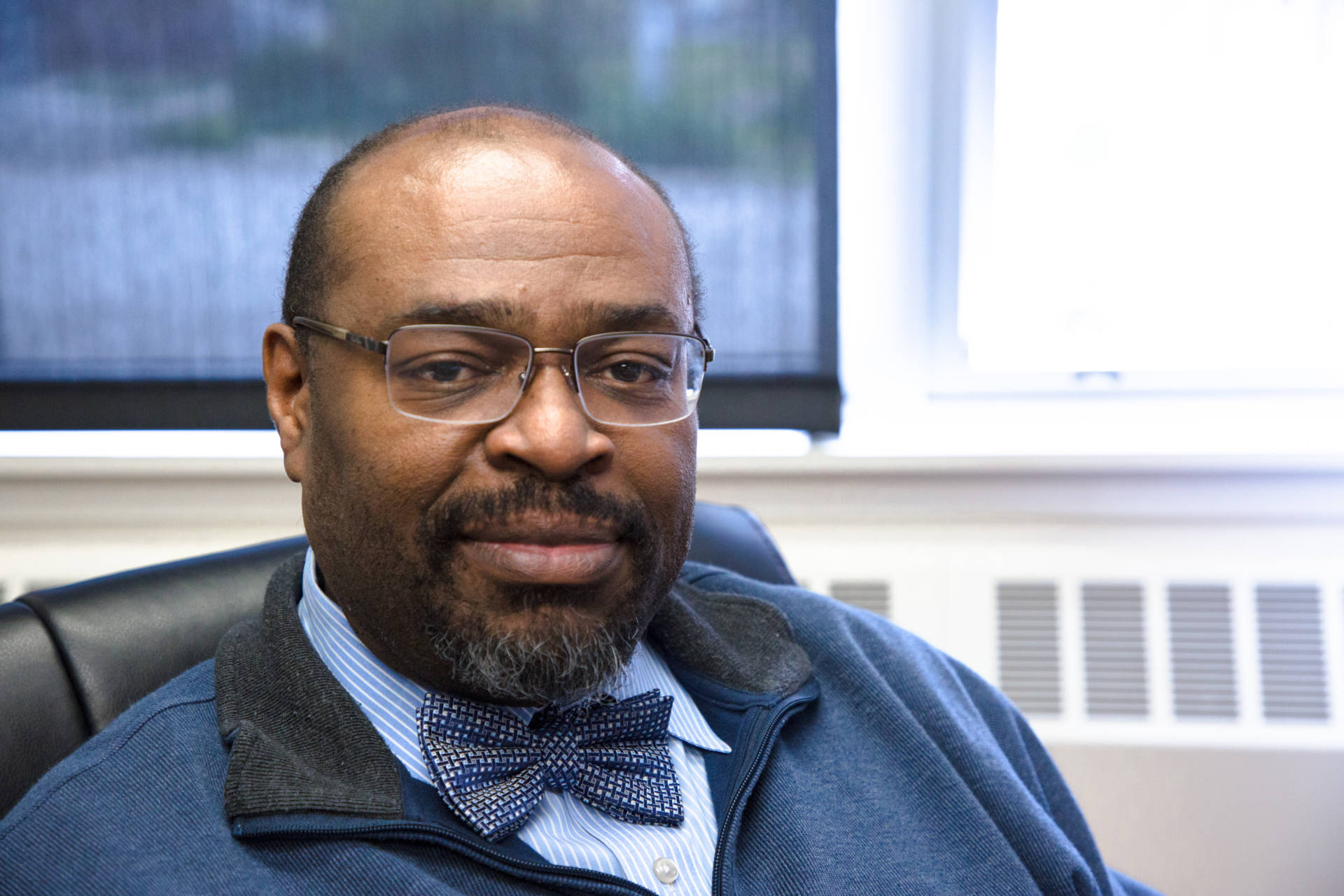MLK and Vis Valley students at Oregon St. vs Cal Football game. Producing life long memories @SFUnified @SFUSD_Supe @pliucb @VVMSFalcons
To hear a podcast version of this story, check out the MindShift Podcast on Apple Podcasts, NPR One, Google Play or wherever you get your podcasts.
Classroom management is an essential tool for an effective teacher, but it’s not always easy to do well. Without an orderly classroom it’s hard for teachers with upward of 25 kids in their classrooms to lead effective lessons, help students who are struggling, and perhaps most important, to trust students. That’s why getting behavior under control was Michael Essien’s number one goal when he started as the assistant principal at Dr. Martin Luther King Jr. Academic Middle School (MLK) in San Francisco.
Essien became an administrator after more than 20 years in Oakland classrooms, where he taught math and special education. He saw firsthand how students responded to project-based learning that was connected to the real world when he became an instructor with the University of California Mathematics, Engineering, Science Achievem.... The program supports students from low-performing or poorly resourced schools in STEM fields through hands-on competitions, summer learning and academic mentoring at school sites throughout the year.
“I saw that kids who are in public school, if they were exposed to certain pedagogy and had certain content, that they can learn regardless of situation,” Essien said. The program doesn’t use lectures. Instead, instructors try to hook kids by posing inquiry-based questions and empowering students to find answers for themselves.
“Kids had a great time, especially since in the project-based learning they had to produce something in the end,” Essien said. “So we had kids doing things like building prosthetic arms — like literally building,” or figuring out how to measure the height of the Campanile on UC Berkeley’s campus. Essien was blown away by what kids could do. But even better, he saw those students return to school with more confidence, succeeding even when the pedagogy of their classrooms wasn’t as dynamic.
“The students actually developed skills around agency that it didn’t make a difference where they went and or who was teaching; kids began to excel in classes,” Essien said.
These experiences made him want to lead similar changes on a larger scale, which brought him to MLK Middle. But teachers there were drowning in behavior issues and burning out along the way. Essien knew he needed to help them manage that before he could convince them to take a plunge into new teaching techniques.
“We were surviving,” Essien said honestly of the tone at MLK when he started four years ago. “Students weren’t learning because students were having challenges in the classroom with their own academic abilities and or behaviors. Teachers who were trying to teach were having a difficult time getting into lessons because they were dealing with behaviors. It was challenging to hold collaborative conversations among the teachers because all teachers could deal with in any setting was the overwhelming behavior.”
MLK serves many students who live in poverty, for whom English is not their first language, and who have been poorly served by the education system for a long time. So it’s no surprise that some students are academically behind and struggle to access grade-level content. When Essien started at MLK, teachers dealt with behavior disruptions by sending students out of class to a room where they waited for the deans in charge of discipline to write them up. While that may have calmed down the classroom, kids soon learned that if the day’s lesson was challenging they could make a disturbance and get sent to a room where many of their friends had also been sent.

Michael Essien greets students warmly during a passing period. (Samantha Shanahan/KQED)
Eighth-grade English and history teacher Jennifer Founds’ classroom was right next door to this holding room. “You would just hear through the walls sort of like screams and loud music and cursing as the one person supervising this room of 10 kids who’ve been kicked out of class is trying to keep things under control,” Founds said. Worse, kids wanted to go there precisely because it was chaotic and out of control. “Especially if a kid has no idea how to do the work for the day, or has a bad relationship with the teacher, or doesn’t think the teacher believes in them, then they’re like, ‘I’m out of here,’ ” Founds said.
Everyone at the school knew something needed to change, but figuring out what would work better was an iterative process. First, Essien thought he could “cocoon” the chronically difficult kids during transition periods, but that didn’t help the classroom dynamic. Then he and the counseling staff tried talking with kids who were sent out of class about what was going on in their lives. They hoped they could leverage the strong relationships they had with kids to get at the underlying problems. They found out that often kids were hungry and traumatized, but that didn’t ultimately solve the classroom behavior issues either.
“At the end of the first year it struck me that we were saying we were holding restorative conversations, but they could not be restorative conversations because the kids didn’t do anything to us,” Essien said. “What needed to be restored was actually in the classroom between the teacher and the classroom where the disruptive behavior occurred.”
So, Essien started trying to support teachers to have restorative conversations in the classroom, at the moment when a disruption occurred. This sounds like a good idea, but in an environment like MLK disruptive behavior was constant, and teachers didn’t always have strong relationships with their students, which are the foundation of effective restorative practices. Restorative practices are still central to the school’s approach, but the burden isn’t all on teachers now.
“We were asking teachers to do too many things,” Essien realized. “They need to be rigorous in their instruction; they need to be big brother/big sister; they need to be counselors; they need to be therapists. And how are teachers supposed to do all of that and still deliver a quality lesson? There was just too much.” He needed to figure out how to remove something from teachers’ plates, not add another big mandate that they felt unprepared to carry out.
That’s when Essien hit on the idea of sending support staff — adults who don’t have teaching roles, like the social worker, deans, academic adviser — into the classroom to help when a situation arose. He calls it “push-in” and his staff started implementing it at the start of Essien’s third year at MLK, but his first year as principal. They had no information about whether it would work or not because they hadn’t been able to run an accurate trial at the end of the previous year. All they knew was that something had to change.

Counselor Clifton Szeto returns from helping a teacher and student with a push-in call. (Samantha Shanahan/KQED)
Here’s how it works: First, Essien got all his teachers trained in de-escalation tactics. They learned about how nonverbal communication, tone, volume, cadence, word choice and proximity work to either escalate or de-escalate a situation. Now, when a teacher sees that a student has become escalated, rather than engaging with her and potentially worsening the situation, teachers pick up the phone, call the office for a push-in, and go back to teaching. The support staff all carry walkie-talkies where they receive the call and they respond on a rotation.
“The idea of going to the room and the push-in is to help the teacher repair the damage, the harm that has been done, the disturbance, whatever you want to call it, in the class,” said Antoinette Marracq, who was head counselor at MLK during this transition. When support staff show up in class they can either take over supervising the lesson so the teacher can step out into the hallway and resolve the issue with the student, or intervene themselves. The hope is to help de-escalate the situation and get the student back into class and learning.
“Students ended up learning that, when a teacher calls for a push-in that they were never getting out of class, that somebody was coming,” Essien said. Once students got used to the new system, he said, their behavior started to change. Even the threat of a push-in is enough sometimes to convince a student to get back on task. And in some cases the relationships between teachers and students started to improve as teachers were freed up to talk things out with students.
“I think it communicates this idea that we’re here to learn and our interest, all of our interests, are for students to be in the class and learning and engaged and to feel supported,” Founds said. She says she doesn’t often have to call for push-ins anymore. When the classroom is calmer overall most kids will stay on task and that has allowed her to feel more comfortable giving students more choice and freedom over their assignments.
Eighth-grade students who have experienced these changes agreed that the school culture has improved at MLK. On the whole, they said they felt safer and more supported, although they acknowledged discipline felt stricter. Some students weren’t so sure that the push-in process had improved their relationships with teachers, though. They like teachers who demonstrate some understanding and give them chances to improve before getting upset. It was clear, however, that they like and respect the support staff, even saying they feel bad when a teacher calls for a push-in because it means a support person would have to come to the room.
There are still students who want to get out of class and run around the hallways, but they are the exception now. And, when a serious issue does come up, support staff are more available to streamline support systems, make a phone call home, or suspend a student if warranted.
The push-in system isn’t easy for the support staff, who all have other jobs like coordinating social services for students, conducting counseling sessions, communicating with parents and taking care of the paperwork that accompanies any kind of disciplinary action.
“Push-in is a priority because the student is escalated,” said Clifton Szeto, a dean who handles much of the discipline. “So sometimes we have to drop what we’re doing and go for a push-in, and it makes it hard to get your other things done.” All of the seven support staff have these feelings at times, but they also say the culture and climate of the school has improved dramatically because of the push-in system.
Overall, the disruptions feel worth it. Even better, by working more directly alongside teachers, support staff are sharing some of their knowledge about how to form deep relationships with students. Some teachers even ask for feedback on how they handled different situations, looking for guidance on how to improve.
SHIFTING TEACHING PRACTICES
As an instructional leader Essien has credibility because he spent so long in the classroom, but when he started at MLK teachers were wary of him. He knew he needed to show them he could teach, so they’d trust him as a thought partner on how teaching practices could change. He remembers leading a three-day inquiry with an algebra class that got students making predictions, talking to the adults in their lives about algebraic concepts, and debating mathematical ideas. When the lesson was over, the teacher had a new appreciation for what might be possible in his classroom.
Essien calls this “cognitive disequilibrium,” an experience that displaces teachers from some of their previously held beliefs. With behavior issues causing less stress, teachers are experimenting with project-based learning. MLK held a STEAM night where students displayed their work to the community. Essien said it was a wonderful event, but he noticed that teachers did all the talking. He waited a week so he wouldn’t seem too critical, but then convened teachers to think about how the following year they could get students speaking more. And when the second annual STEAM event rolled around, he said teachers agreed it was even better.
“So what made it better? Teachers still did the same work in terms of working with kids and projects, but the students presented.” Now he’s thinking about how he can make sure every kid presents, and how the school could do themed nights in every subject.

Principal Michael Essien in his office. (Samantha Shanahan/KQED)
“I’m the guy who is always thinking about how can we drill deeper. How can we make something better,” Essien said. “So although I feel good that we’re making these changes, I’m thinking still: How can I support teachers in increasing their capacity.” This quality might also be why Essien has been successful at MLK, something he attributes to his special education training. He’s used to making a plan, evaluating if it’s working, and changing course if goals aren’t being met.
MLK still deals with some behavior issues; it hasn’t completely transformed. But there’s a feeling that all the adults in the building are working toward the same goal and they’ve got a leader who has articulated a clear vision — make MLK Middle the best school in San Francisco. Essien knows his students deserve that.







You need to be a member of School Leadership 2.0 to add comments!
Join School Leadership 2.0